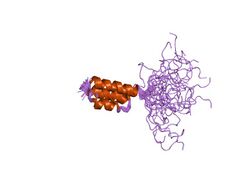Biology:GA module
| GA module | |||||||||
|---|---|---|---|---|---|---|---|---|---|
 solution structure of the albumin binding domain of streptococcal protein g | |||||||||
| Identifiers | |||||||||
| Symbol | GA | ||||||||
| Pfam | PF01468 | ||||||||
| InterPro | IPR002988 | ||||||||
| SMART | TBC | ||||||||
| PROSITE | PDOC00406 | ||||||||
| MEROPS | C44 | ||||||||
| SCOP2 | 1fkm / SCOPe / SUPFAM | ||||||||
| TCDB | 4.A.6 | ||||||||
| CAZy | GT16 | ||||||||
| |||||||||
In molecular biology, the GA module, or protein G-related albumin-binding module, is a protein domain which occurs on the surface of numerous Gram-positive bacterial pathogens. Protein G of group C and G Streptococci interacts with the constant region of IgG and with human serum albumin. The GA module is composed of a left-handed three-helix bundle and is found in a range of bacterial cell surface proteins.[1][2] GA modules may promote bacterial growth and virulence in mammalian hosts by scavenging albumin-bound nutrients and camouflaging the bacteria. Variations in sequence give rise to differences in structure and function between GA modules in different proteins, which could alter pathogenesis and host specificity due to their varied affinities for different species of albumin.[3] Proteins containing a GA module include PAB from Peptostreptococcus magnus.[4]
References
- ↑ "Crystal structure and biological implications of a bacterial albumin binding module in complex with human serum albumin". J. Biol. Chem. 279 (41): 42924–8. October 2004. doi:10.1074/jbc.M406957200. PMID 15269208.
- ↑ "Solution structure of the albumin-binding GA module: a versatile bacterial protein domain". J. Mol. Biol. 266 (5): 859–65. March 1997. doi:10.1006/jmbi.1996.0856. PMID 9086265.
- ↑ "Structure, dynamics, and stability variation in bacterial albumin binding modules: implications for species specificity". Biochemistry 45 (33): 10102–9. August 2006. doi:10.1021/bi060409m. PMID 16906768.
- ↑ "The GA module, a mobile albumin-binding bacterial domain, adopts a three-helix-bundle structure". FEBS Lett. 374 (2): 257–61. October 1995. doi:10.1016/0014-5793(95)01121-T. PMID 7589548.
 |

